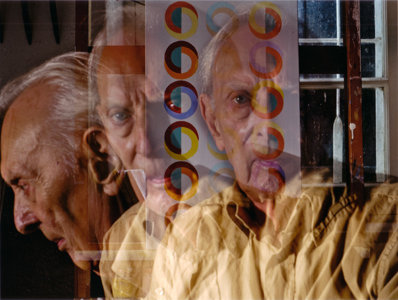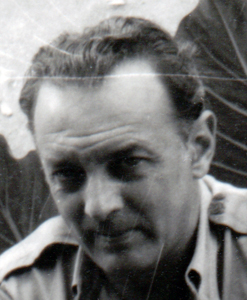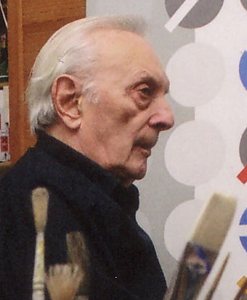 Carlo Nangeroni was born in New York on June 24 1922 into a family of immigrants from Lombardy. From 1938 to 1942 he attended courses at the "School of Christian Art Beato Angelico" in Milan and at the same time evening courses at Brera where he studied with Mauro Reggiani. In 1946 he moved back to the United States and settled in New York where his family lived. These were years of life experiences, experiments and research in the field of art in contact with the new way of American painting and the affirmation of its major artists. In the spring of 1948 he met the sculptor Alexander Archipenko, at that time in New York, and attended his study. In those years came into contact with the ideas and the protagonists of '"action painting" as Willem de Kooning and Franz Kline. At the same time he began to know and got interested in the experiments on sounds and noises that the composer Edgar Varèse led in his studio workshop in Mac Dougal Street. Met poets and writers like Alastair Reed, Octavio Paz, Jorge Guillen. In 1949 he held his first exhibition at the "New York circulating gallery of paintings." For a brief period he experimented with abstract expressionist painting. The works of this period will then be exhibited in a solo show in 1958 at the Meltzer gallery in 57th Street. In those years, he also worked for the television network "National Broadcasting Company" as a set designer painting sets for opera and theater, among which, for the opera "Macbeth" by Verdi, "The Magic Flute" Mozart's "Amal and the Night Visitors" by Menotti and prose productions as "Richard the second" and "Macbeth" by Shakespeare, "Cyrano de Bergerac" by Rostand and more. He began exhibiting in group exhibitions at the "Pennsylvania National Academy" in Philadelphia, the "College of Fine Arts" at the University of Illinois, "the Detroit Institute of Arts" in Detroit. From 1954 to 1957 he created a series of works almost monochrome (white with small additions of color) with a strong "texture" and slightly raised, where figural memories mingle with inoggettive scores. In 1958 he collaborated on an advertising project entitled "the Chrisalis" by Salvador Dali for a pharmaceutical company that produced the first tranquilizers.
Carlo Nangeroni was born in New York on June 24 1922 into a family of immigrants from Lombardy. From 1938 to 1942 he attended courses at the "School of Christian Art Beato Angelico" in Milan and at the same time evening courses at Brera where he studied with Mauro Reggiani. In 1946 he moved back to the United States and settled in New York where his family lived. These were years of life experiences, experiments and research in the field of art in contact with the new way of American painting and the affirmation of its major artists. In the spring of 1948 he met the sculptor Alexander Archipenko, at that time in New York, and attended his study. In those years came into contact with the ideas and the protagonists of '"action painting" as Willem de Kooning and Franz Kline. At the same time he began to know and got interested in the experiments on sounds and noises that the composer Edgar Varèse led in his studio workshop in Mac Dougal Street. Met poets and writers like Alastair Reed, Octavio Paz, Jorge Guillen. In 1949 he held his first exhibition at the "New York circulating gallery of paintings." For a brief period he experimented with abstract expressionist painting. The works of this period will then be exhibited in a solo show in 1958 at the Meltzer gallery in 57th Street. In those years, he also worked for the television network "National Broadcasting Company" as a set designer painting sets for opera and theater, among which, for the opera "Macbeth" by Verdi, "The Magic Flute" Mozart's "Amal and the Night Visitors" by Menotti and prose productions as "Richard the second" and "Macbeth" by Shakespeare, "Cyrano de Bergerac" by Rostand and more. He began exhibiting in group exhibitions at the "Pennsylvania National Academy" in Philadelphia, the "College of Fine Arts" at the University of Illinois, "the Detroit Institute of Arts" in Detroit. From 1954 to 1957 he created a series of works almost monochrome (white with small additions of color) with a strong "texture" and slightly raised, where figural memories mingle with inoggettive scores. In 1958 he collaborated on an advertising project entitled "the Chrisalis" by Salvador Dali for a pharmaceutical company that produced the first tranquilizers.

In 1958 he returned to Italy and moved to Milan to devote himself exclusively to painting. In November 1959 he had his first exhibition in Italy at the Schneider Gallery in Rome with sculptor Carmelo Cappello. The exhibition was also attended by Willem de Kooning who, in those days was, visiting Rome. In 1960 his informal period was ending and he transformed the free brushstrokes into defined plastic elements beginning to experiment with rational organization. His arched strokes became semicircular elements which, in turn, originated the circle that became a constant basis of his work. In Milan he got acquainted with the artistic community of the city. Met artists like Gianni Colombo, Piero Manzoni, Lucio Fontana, "Gruppo T", Paul Schiavocampo, Gianni Brusamolino, Miro Cusumano, critics Franco Russoli, Marco Valsecchi, Carlo Belloli and many others. In 1963 he met the art dealer Bruno Lorenzelli who offered him an exclusive contract that lasted until 1973. In the same year he organized an exhibition in Bergamo presented by critic Marco Valsecchi. In 1963 he met Emilio Scanavino who invited him to Calice Ligure, on the Riviera. Nangeroni bought a summer home there and soon after many other Italian and foreign artists decided to spend their summer in Calice Ligure giving birth to a very busy colony. Nangeroni exhibited for the first time in Milan in 1965 at Bruno Lorenzelli junior's Gallery with a preface to the catalog written by Michel Seuphor. In the same year he was invited to the ninth Quadrennial of Rome. In 1967 he was invited together with Emilio Scanavino, Arturo Bonfanti, Carmelo Cappello and Renato Volpini at the "Art Alliance Foundation" in Philadelphia. In 1968 he married Mary D'Orazio. Between 1968 and 1969 he was invited to the "Musée d'Art Moderne" for the exhibition "Réalités Nouvelles". In 1968 he designed the sets for De Falla's "El retablo de Maese Pedro", Dalla Piccola's "Job", and "Oedipus Rex" by Stravinsky for the season of the Teatro Comunale Margherita of Genoa. In 1972 he was invited to the Venice Biennale. In those years he worked in order to develop a "grammar" of work, mainly using ranges of grays on white backgrounds and almost abandoning all color.
 In 1973 he was invited to the tenth Quadrennial in Rome. In 1981 he discovered the wonders of the combinations, the thematic variations and ambiguities of color experiences and then developed an iridescent coloring by means of combinations of vertical colored lines and small diagonals forming a latticework of microstructures where the light became a constant interest in his work. In 1984, paints a fresco of six meters by two and eighty in the Melzi estate in Cavaglià (Vercelli). In 1986 he was invited to the Venice Biennale in the section "Colore, aspetti della ricerca cromatica organizzata" and to the Eleventh Quadrennial of Rome. his research continued during the nineties, his work fragmented into particles with color backgrounds, to achieve higher luminous vibration. In 1994, he has two major anthological exhibitions at the Palazzo Ducale in Massa and at the Bibliomediateca in city of Terni presented by critic Luciano Caramel. From 1973 to 2004 he taught at the "Scuola Politecnica di Design" in Milan. His works are in collections in the United States, France, Germany, Italy, in the contemporary art collection of New York University, the Gallery of Modern Art in Turin and in many other exhibitions in the United States in France, Germany, Switzerland.
In 1973 he was invited to the tenth Quadrennial in Rome. In 1981 he discovered the wonders of the combinations, the thematic variations and ambiguities of color experiences and then developed an iridescent coloring by means of combinations of vertical colored lines and small diagonals forming a latticework of microstructures where the light became a constant interest in his work. In 1984, paints a fresco of six meters by two and eighty in the Melzi estate in Cavaglià (Vercelli). In 1986 he was invited to the Venice Biennale in the section "Colore, aspetti della ricerca cromatica organizzata" and to the Eleventh Quadrennial of Rome. his research continued during the nineties, his work fragmented into particles with color backgrounds, to achieve higher luminous vibration. In 1994, he has two major anthological exhibitions at the Palazzo Ducale in Massa and at the Bibliomediateca in city of Terni presented by critic Luciano Caramel. From 1973 to 2004 he taught at the "Scuola Politecnica di Design" in Milan. His works are in collections in the United States, France, Germany, Italy, in the contemporary art collection of New York University, the Gallery of Modern Art in Turin and in many other exhibitions in the United States in France, Germany, Switzerland.
Carlo Nangeroni died in Milan the 13th of March 2018 at 95.